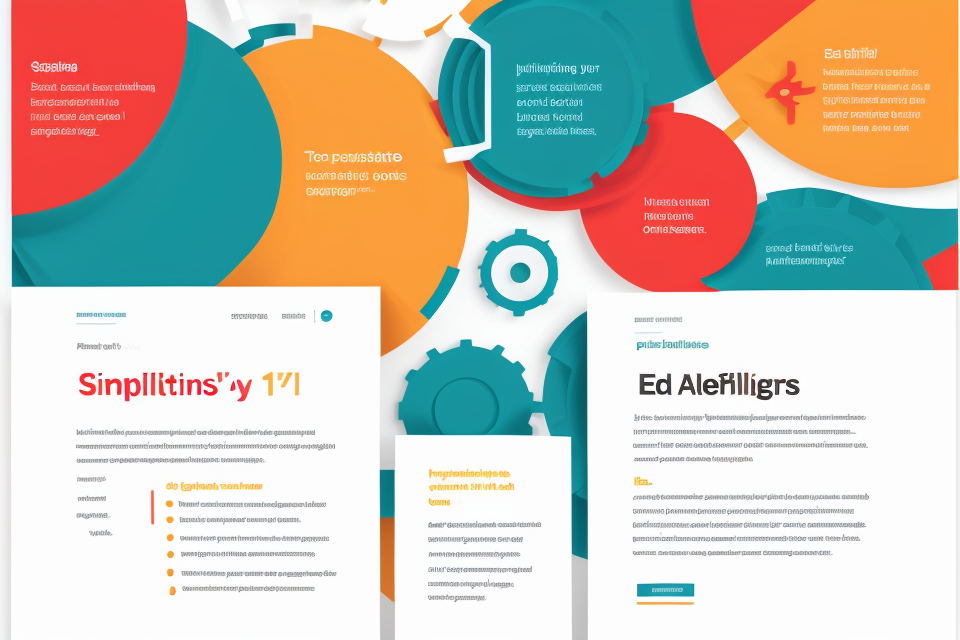
In today’s fast-paced digital world, software optimization has become an essential aspect of improving system performance. With the increasing demand for speed and efficiency, optimizing software has become a necessity for businesses and individuals alike. But how does software optimization work? In this comprehensive guide, we will explore the intricacies of software optimization and provide you with the tools to boost your system’s performance. From understanding the different types of optimization to implementing effective strategies, this guide will take you on a journey to unlock the full potential of your software. Get ready to learn the secrets to unleashing lightning-fast performance and take your system to new heights!
Understanding Software Optimization
What is software optimization?
- Definition and explanation
- Software optimization refers to the process of improving the performance of software by identifying and eliminating inefficiencies, reducing resource usage, and enhancing code efficiency. It involves the use of various techniques and tools to optimize the software’s execution and enhance its overall performance.
- Importance of software optimization
- Optimizing software is crucial for several reasons, including improving system performance, reducing resource usage, lowering energy consumption, enhancing user experience, and enabling faster and more efficient software development.
- By optimizing software, businesses can reduce their operating costs, enhance their product’s competitiveness, and improve customer satisfaction.
- Optimizing software is also important for developers as it allows them to write more efficient code, reduce bugs and errors, and enhance the overall quality of their software products.
Types of software optimization
When it comes to software optimization, there are several types that can be performed to improve the performance of a system. These include:
- Code optimization: This type of optimization involves modifying the source code of a program to make it run more efficiently. This can include things like reducing the number of instructions executed, minimizing the use of conditional statements, and eliminating unnecessary steps in the code.
- Memory optimization: Memory optimization is the process of improving the efficiency of how a program uses memory. This can include things like reducing memory leaks, minimizing the use of dynamic memory allocation, and using data structures that require less memory.
- Performance optimization: Performance optimization is the process of improving the overall speed and efficiency of a program. This can include things like optimizing algorithms, minimizing I/O operations, and reducing the number of context switches.
- Compiler optimization: Compiler optimization is the process of improving the performance of a program by modifying the way the compiler generates code. This can include things like optimizing the use of registers, reducing the size of the generated code, and minimizing the number of function calls.
By understanding the different types of software optimization, developers can choose the most appropriate techniques to improve the performance of their systems.
How software optimization affects system performance
- Reduced resource usage
- Faster program execution
- Improved system stability
Software optimization refers to the process of improving the performance of software applications by making them more efficient and effective. By optimizing software, developers can enhance the overall performance of the system, leading to reduced resource usage, faster program execution, and improved system stability.
Reducing resource usage is one of the primary benefits of software optimization. By optimizing code, developers can reduce the amount of memory and processing power required to run the software, resulting in lower system resource usage. This can be particularly beneficial for resource-constrained devices such as smartphones and tablets, where performance is often limited by the available hardware resources.
Another way that software optimization affects system performance is by improving program execution speed. By optimizing code, developers can reduce the amount of time required to execute programs, resulting in faster program execution. This can be particularly beneficial for applications that require high levels of processing power, such as video editing software or gaming applications.
Finally, software optimization can also improve system stability. By optimizing code, developers can reduce the likelihood of errors and bugs, resulting in a more stable system. This can be particularly beneficial for mission-critical applications, where system stability is essential to ensure that the application continues to function correctly.
In conclusion, software optimization is a crucial process for improving the performance of software applications. By reducing resource usage, improving program execution speed, and improving system stability, software optimization can help developers create more efficient and effective software applications that deliver better performance and a more satisfying user experience.
Common Optimization Techniques
Code optimization
Code optimization refers to the process of improving the efficiency and performance of software by modifying the source code. This technique is widely used in software development to enhance the execution speed and reduce the memory usage of programs. Here are some of the key methods used in code optimization:
- Identifying and removing unnecessary code: One of the most common code optimization techniques is to identify and remove unnecessary code. This involves analyzing the code to identify any functions or statements that do not contribute to the functionality of the program. Removing this code can significantly improve the performance of the software.
- Minimizing the number of function calls: Another code optimization technique is to minimize the number of function calls. Function calls can slow down the execution of a program, especially if they are made repeatedly. By minimizing the number of function calls, the program can be made more efficient and faster.
- Improving the efficiency of algorithms: The efficiency of algorithms can also be improved through code optimization. Algorithms are sets of instructions that are used to solve a particular problem. By optimizing the algorithms used in a program, the execution time can be reduced, resulting in faster performance. This can be achieved by using more efficient data structures, reducing the number of iterations, or optimizing the logic of the algorithm.
In addition to these techniques, code optimization may also involve other methods such as profiling, caching, and parallel processing. Profiling involves analyzing the performance of a program to identify areas that can be optimized. Caching involves storing frequently used data in memory to reduce the number of times it needs to be retrieved. Parallel processing involves dividing a program into smaller parts and running them simultaneously to reduce the overall execution time.
Memory optimization
- Managing memory usage effectively
- Reducing memory leaks
- Avoiding memory fragmentation
Memory optimization is a critical aspect of software optimization, as it directly affects the performance of a system. The main goals of memory optimization are to reduce memory usage, minimize memory leaks, and avoid memory fragmentation. This section will delve into each of these goals in detail.
Managing memory usage effectively
Effective memory management involves allocating and deallocating memory as needed by the system, without causing memory-related errors or crashes. Techniques such as smart pointers, memory pools, and reference counting can help manage memory usage effectively.
Smart pointers, for example, automatically manage memory allocation and deallocation, reducing the risk of memory leaks and buffer overflows. Memory pools can be used to manage memory allocations for a group of objects, reducing the overhead of individual memory allocations. Reference counting, on the other hand, keeps track of the number of references to an object, allowing the system to deallocate memory when the last reference is released.
Reducing memory leaks
Memory leaks occur when memory is allocated but not deallocated properly, causing the system to consume an increasing amount of memory over time. Common causes of memory leaks include dynamic memory allocation, global variables, and uninitialized pointers.
To reduce memory leaks, it is essential to identify and fix the root cause of the leak. This may involve using automated memory debugging tools, reviewing code for memory allocation errors, or using techniques such as smart pointers or garbage collection to automatically manage memory.
Avoiding memory fragmentation
Memory fragmentation occurs when the available memory is divided into small, non-contiguous blocks, making it difficult for the system to allocate large blocks of memory. This can lead to performance issues and may cause the system to crash.
To avoid memory fragmentation, techniques such as memory compaction or memory pooling can be used. Memory compaction involves moving memory blocks around to form larger, contiguous blocks, while memory pooling involves managing a pool of memory that can be allocated and deallocated as needed.
In conclusion, memory optimization is a critical aspect of software optimization, as it directly affects the performance of a system. By managing memory usage effectively, reducing memory leaks, and avoiding memory fragmentation, software developers can optimize their systems for better performance and stability.
Performance optimization
Performance optimization is a crucial aspect of software development that aims to enhance the efficiency and speed of software applications. This technique involves analyzing and identifying performance bottlenecks and implementing effective optimization strategies to improve the utilization of system resources. In this section, we will delve into the details of performance optimization and explore some of the key techniques used to boost the performance of software applications.
Profiling and analyzing performance bottlenecks
The first step in performance optimization is to identify the performance bottlenecks that are hindering the efficiency of the software application. Profiling is a technique used to measure and analyze the performance of software applications. It involves collecting data on various aspects of the application’s performance, such as CPU usage, memory allocation, and I/O operations. This data is then analyzed to identify the performance bottlenecks that are causing the application to slow down or crash.
Once the performance bottlenecks have been identified, the next step is to analyze them in detail to determine the root cause of the problem. This analysis involves identifying the specific functions or code segments that are causing the bottlenecks and determining how they can be optimized to improve performance.
Implementing optimization strategies
Once the performance bottlenecks have been identified and analyzed, the next step is to implement optimization strategies to improve the efficiency of the software application. There are several techniques used to optimize the performance of software applications, including:
- Code optimization: This involves modifying the code of the software application to improve its efficiency. Techniques used in code optimization include loop unrolling, function inlining, and dead code elimination.
- Memory management optimization: This involves optimizing the way the software application uses memory to improve its performance. Techniques used in memory management optimization include memory pooling, garbage collection, and memory compression.
- I/O optimization: This involves optimizing the way the software application performs input/output operations to improve its performance. Techniques used in I/O optimization include buffering, caching, and asynchronous I/O.
Utilizing system resources efficiently
In addition to optimizing the code and memory management of the software application, it is also important to optimize the way the application utilizes system resources such as CPU, disk, and network. This can be achieved by:
- Parallel processing: This involves dividing a task into smaller parts and executing them simultaneously to improve performance.
- Caching: This involves storing frequently accessed data in memory to reduce the number of I/O operations and improve performance.
- Network optimization: This involves optimizing the way the software application communicates over the network to improve performance. Techniques used in network optimization include packet fragmentation, flow control, and congestion avoidance.
Overall, performance optimization is a critical aspect of software development that involves analyzing and identifying performance bottlenecks and implementing effective optimization strategies to improve the efficiency and speed of software applications. By following the techniques outlined above, developers can improve the performance of their software applications and provide a better user experience.
Compiler optimization
Compiler optimization is a technique used to improve the performance of software by optimizing the code generated by a compiler. The process involves modifying the code generated by the compiler to make it run faster.
- Utilizing compiler optimizations
- Understanding the benefits of compiler optimizations
- Examples of compiler optimizations
- Customizing compiler options
- Overview of compiler options
- How to customize compiler options
- Impact of customizing compiler options
- Understanding the impact of optimization settings
- Explanation of optimization settings
- Understanding the trade-offs of optimization settings
- Recommendations for optimization settings
,,
Best Practices for Software Optimization
Staying up-to-date with industry standards
One of the best ways to optimize your software is to stay up-to-date with industry standards. This involves following best practices and guidelines, as well as keeping up with new optimization techniques.
Following best practices and guidelines
By following industry best practices and guidelines, you can ensure that your software is designed and implemented in a way that is efficient and effective. These practices and guidelines are often developed by experts in the field and are based on years of experience and research.
For example, following coding standards such as the Google C++ Style Guide or the Java Coding Conventions can help ensure that your code is readable, maintainable, and efficient. Similarly, following security best practices such as input validation and encryption can help protect your software from vulnerabilities and attacks.
Keeping up with new optimization techniques
Software optimization is a constantly evolving field, and new techniques and tools are constantly being developed. By keeping up with these developments, you can stay ahead of the curve and ensure that your software is as efficient and effective as possible.
This might involve attending conferences and workshops, reading industry publications, or participating in online communities and forums. It’s important to stay curious and open-minded, and to be willing to try new approaches and tools as they become available.
Overall, staying up-to-date with industry standards is an essential part of software optimization. By following best practices and guidelines, and by keeping up with new optimization techniques, you can ensure that your software is designed and implemented in a way that is efficient, effective, and secure.
Utilizing efficient programming languages and libraries
When it comes to software optimization, choosing the right programming language and utilizing efficient libraries and frameworks can make a significant difference in the performance of your application. Here are some best practices to consider:
- Choosing the right language for the task: Different programming languages have their strengths and weaknesses, and choosing the right one for the task at hand can have a significant impact on performance. For example, languages like C and C++ are highly efficient and can be used to create high-performance applications, while languages like Python and JavaScript are more suitable for rapid prototyping and web development.
- Using efficient libraries and frameworks: Many programming languages have libraries and frameworks that can help you optimize your code and improve performance. For example, in C++, the Standard Template Library (STL) provides a set of efficient algorithms and data structures that can be used to perform common tasks such as sorting and searching. Similarly, in Python, the NumPy library provides efficient support for numerical computations, while the Django framework can help speed up web development by providing a set of pre-built components and tools.
It’s important to note that while efficient libraries and frameworks can help improve performance, they can also add overhead if not used correctly. It’s essential to understand how these tools work and to use them in a way that is optimized for your specific application.
Additionally, it’s worth considering the performance characteristics of the runtime environment in which your application will run. For example, if your application is designed to run on a mobile device, you may need to consider the impact of battery life and other constraints on performance. By choosing the right programming language and libraries, and by designing your application with performance in mind, you can ensure that your software runs smoothly and efficiently, even under challenging conditions.
Regularly monitoring and analyzing system performance
Effective software optimization requires consistent monitoring and analysis of system performance. This can help identify potential bottlenecks and areas for improvement, ensuring that your software runs efficiently and effectively. Here are some key steps to consider when regularly monitoring and analyzing system performance:
- Implementing monitoring tools and processes: Utilize tools and processes specifically designed to monitor and measure software performance. These tools can help gather data on system resource usage, network traffic, and other critical metrics. It’s important to choose tools that are compatible with your software and hardware environment, and that provide comprehensive and accurate data.
- Setting up performance benchmarks: Establish baseline performance metrics to compare against as your software evolves. These benchmarks should be tailored to your specific application and can include metrics such as response time, throughput, and resource utilization. Having a clear understanding of these benchmarks will help you identify deviations from expected performance and determine whether optimization efforts are effective.
- Analyzing performance data: Regularly review performance data collected by your monitoring tools to identify trends, bottlenecks, and areas for improvement. This analysis should involve both quantitative and qualitative measures, such as examining CPU usage, memory allocation, and network latency. Additionally, consider factors such as user behavior, network conditions, and hardware limitations that may impact performance.
- Investigating performance anomalies: When performance deviates from established benchmarks, it’s important to investigate the root cause of the issue. This may involve a deeper dive into the code, examining system logs, or conducting load testing to simulate real-world scenarios. It’s crucial to identify the specific cause of any performance issues to ensure that optimization efforts are focused on the most impactful areas.
- Implementing changes and retesting: Once areas for improvement have been identified, implement changes to the software and retest performance. This may involve optimizing code, refactoring algorithms, or adjusting system configurations. It’s important to rigorously test these changes to ensure they have the desired impact on performance and do not introduce new issues.
By regularly monitoring and analyzing system performance, you can proactively identify areas for optimization and ensure that your software runs efficiently and effectively.
FAQs
1. What is software optimization?
Software optimization refers to the process of improving the performance of software applications by identifying and removing bottlenecks, reducing memory usage, and minimizing CPU and I/O usage. This results in faster and more efficient software that can handle more tasks and run smoothly.
2. Why is software optimization important?
Software optimization is important because it helps to improve the performance of software applications, which can result in faster response times, reduced resource usage, and better overall system performance. By optimizing software, users can experience smoother and more efficient operation, leading to improved productivity and user satisfaction.
3. What are some common techniques used in software optimization?
Some common techniques used in software optimization include code profiling, memory management, and caching. Code profiling involves analyzing the performance of code to identify slow or inefficient functions, while memory management involves optimizing the use of memory to reduce memory usage and improve performance. Caching involves storing frequently accessed data in memory to reduce the number of I/O operations and improve performance.
4. How can I optimize my software?
There are several ways to optimize your software, including:
* Profiling your code to identify performance bottlenecks
* Improving memory management to reduce memory usage
* Implementing caching to reduce I/O operations
* Minimizing CPU and I/O usage through careful design and implementation
* Using optimization libraries and tools to help identify and fix performance issues
5. What are the benefits of software optimization?
The benefits of software optimization include improved performance, faster response times, reduced resource usage, and improved system stability. By optimizing software, users can experience smoother and more efficient operation, leading to improved productivity and user satisfaction. Additionally, optimized software can help to reduce the overall workload on a system, making it more reliable and efficient.


